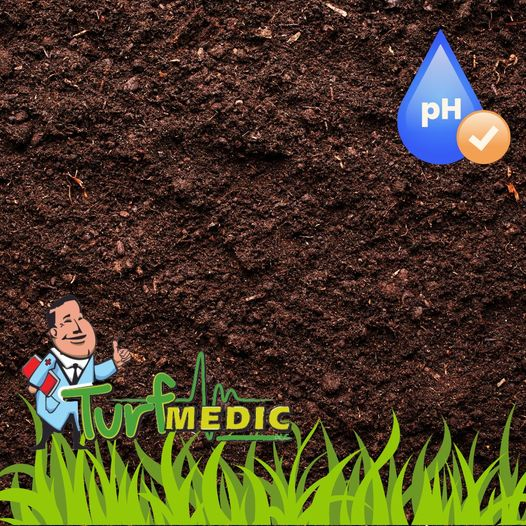Knowing the pH level of your soil is important if you want your plants, including your lawn, to thrive. If you don’t want to worry about taking soil samples and determining the amount of which substances to add if the pH is too high or low, with Turf Medic’s lawn care service we can take care of it for you.
Want to transform your lawn in 2023? We can help! Sign on for a Turf Medic lawn care program – you won’t be disappointed! Contact us today to learn how we can treat your lawn.
Why Use Turf Medic To Know Your Soil Ph Level?
Soil pH is an important factor when it comes to the growth and health of your lawn. A balanced soil pH level will help maximize the potential for optimal turfgrass growth, especially when combined with proper fertilization and watering practices. That’s why it’s important to regularly monitor and adjust your soil pH levels.
Fortunately, that doesn’t have to be a daunting task. With the help of Turf Medic, you can easily test your soil’s pH levels and identify any issues that may be preventing your lawn from growing at its best.
Turf Medic uses a simple “dip-stick” system to measure the pH level of your lawn’s soil. The automated process takes only seconds, and gives you an accurate and reliable reading that you can use to determine if your soil needs adjustments. The pH levels are displayed on a color coded scale, making it easy to understand the results.
The Turf Medic system also includes helpful recommendations about what types of treatments or amendments may be needed to adjust the pH level of your lawn’s soil. This makes it easier for you to take the necessary action and get your lawn back on track.
With Turf Medic, you can ensure that your soil pH levels are properly balanced and give your lawn the best chance for success! Get started with Turf Medic today and see how easy it is to monitor your soil’s pH levels.
What Is Soil Ph And Why Is It Important For Turfgrass Growth
Soil pH is one of the most important factors for healthy turfgrass growth. It determines how easily plants can take up nutrients from the soil and how efficiently they can use those nutrients to grow. A soil pH that is too low or too high can lead to poor plant health and disease. Fortunately, it’s easy to measure soil pH with a simple soil testing kit.
Knowing your soil’s pH level is essential if you want to create a healthy environment for turfgrass growth. When the pH is too low, certain nutrients become unavailable to plants and they can be more vulnerable to disease. On the other hand, when the pH is too high, it can lead to nutrient deficiencies and mineral toxicity.
It is best to aim for a soil pH of 6.5-7.0, which is considered optimal for most turfgrass species. When the pH falls outside this range, you can adjust it by adding lime or sulfur (or both). It’s also important to regularly aerate your lawn and add organic matter such as compost and mulch to improve soil structure, increase nutrient availability, and help maintain an optimal pH level.
By taking the time to measure and adjust your soil’s pH level, you’ll ensure that your turfgrass is getting all the nutrients it needs for healthy growth. This will result in a lush, green lawn that is less prone to disease. So make sure you add soil testing to your lawn care routine! Turf Medic will help you to achieve all you need for your lawn.
Steps To Test Your Soil’s Ph Level
It is important to understand the pH level of your soil in order to optimize maximum plant growth. The following steps will guide you through the process of testing the pH level of your soil.
Step 1: Gather Supplies
To test your soil’s pH level, you’ll need a few items:
- A pH Test Kit: This kit will usually include a soil testing strip that changes color when placed in soil.
- A Sharp Tool: You’ll need something to dig into the ground with. Anything from a garden trowel to a spoon can work!
- Water: The test strips may require you to mix some water into the soil sample.
Step 2: Collect Soil Sample
Once you have the supplies, you’ll need to collect a soil sample. To do this, use your sharp tool to dig a hole about 3-4 inches deep in the soil. Once the hole is deep enough, remove a few tablespoons of soil and place it into a container or bag.
Step 3: Prepare Soil Sample
Before testing the soil’s pH level, you’ll need to prepare the soil sample. Add a few tablespoons of water into the container with your soil and mix it together until it forms a paste-like consistency.
Step 4: Test The Soil
Now that your soil is prepared, you can test its pH level. Take your pH test strip and dip it into the soil paste. The color of the strip will indicate the pH level of your soil – if it turns yellow, your soil is acidic; if it turns blue, your soil is alkaline.
Step 5: Adjust Soil As Needed
If you find that your soil’s pH level is too low or too high for your plant’s needs, you can adjust it. To make the soil more acidic, add sulfur or peat moss to the soil. For alkaline soils, add organic matter like compost or manure to help lower the pH level.
By following these steps, you’ll be able to get a better understanding of the pH level of your soil and take the necessary steps to optimize growth for your plants. With a little effort, you’ll be able to have lush, healthy soil that will support beautiful, vibrant plants.
Step 6: Re-Test The Soil
Once you’ve made any adjustments to your soil’s pH level, it is important to test it again to make sure it is at the desired level. Follow the same steps as before, and re-measure your soil’s pH level to ensure that it is correct for your plants.
Now that you know how to test and adjust your soil’s pH level, you’ll be able to create an optimal growing environment for your plants. With a healthy soil base, you can achieve beautiful results with Turf Medic’s soil pH testing solution.
Benefits Of Maintaining The Proper Soil Ph Level
One of the most important things you can do to ensure a lush and healthy lawn is to ensure that the soil pH level is properly balanced. The soil pH, or potential hydrogen, refers to how acidic or alkaline the soil is. The range for an ideal balance falls between 6.0-7.0 on the pH scale.
Soil with too much acidity can cause your grass to suffer from nutrient deficiencies, resulting in discoloration and stunted growth. Too much alkalinity can have the same effect. Therefore, it’s important to maintain a balanced soil pH level for optimal lawn health.
Here are some of the benefits of maintaining proper soil pH levels:
- Better Nutrient Uptake: By keeping the soil pH level in check, you can ensure that your grass is able to absorb essential nutrients from the soil more effectively.
- Improved Turf Performance : Properly balanced soil pH levels leads to improved turf performance and a thicker, greener lawn.
- Reduced Need For Fertilizer & Pesticides: Having balanced soil pH levels can reduce the need for fertilizer and pesticides, saving you money in the long run.
- Enhanced Pest & Disease Resistance: Balanced soil pH levels can help your lawn to resist pests and disease more effectively.
- Improved Soil Quality: Keeping the soil pH level in check helps to improve its overall quality, which leads to a healthier lawn.
Maintaining the proper soil pH level for your lawn is crucial if you want to enjoy a lush and healthy yard. With proper care and maintenance, you can ensure that your grass has the best chance at optimal health. If you’re unsure of how to test and adjust the soil pH levels in your yard, Turf Medic Today!
Common Causes Of Improper Soil Ph Levels
When it comes to caring for your lawn, understanding the pH of your soil is an important factor in keeping a healthy lawn. Knowing what can cause improper pH levels in your lawn can help you identify and address issues quickly before they become big problems.
One common cause of unbalanced soil pH is incorrect fertilizing. Over-fertilizing with acidic fertilizers can lower the pH levels of your soil, making it more acidic and leading to nutrient deficiencies in your plants. On the other hand, over-fertilizing with alkaline products can raise the pH levels of your soil and cause poor plant growth due to a lack of essential nutrients.
Failing to do proper maintenance on your lawn can also lead to an imbalance in your soil pH. When you don’t mow and rake regularly, thatch can build up in your lawn, leading to poor drainage, increased runoff, and ultimately a decrease in the acidity of your soil.
Watering is another factor that can affect your soil pH levels. Water with high levels of chlorine or fluoride can lead to an increase in the alkalinity of your soil over time. If you have hard water, be sure to test it regularly and take steps to reduce its levels if necessary.
Finally, certain types of acid-loving plants can lead to a decrease in the pH level of your lawn. These include rhododendrons, azaleas, blueberries, and pine trees. If you have any of these plants in your lawn, be sure to monitor the acidity of your soil more closely.
Keeping a healthy pH level in your soil is an important factor in maintaining a lush and vibrant lawn.
Methods Of Adjusting Your Soil’s Ph Level
To make sure your lawn is as green and lush as possible, it’s important to understand the soil pH level of your lawn. Different grasses prefer different levels of acidity, and understanding how to manage the pH level of your soil will help you keep a healthy lawn.
There are two primary methods for adjusting the soil’s pH level: physical and chemical methods.
The physical method involves making changes to the composition of the soil, such as adding organic matter like compost or peat moss. This can help increase alkalinity in the soil, raising its pH level. It also helps improve drainage and aeration of the soil, which is essential for healthy grass growth.
Chemical methods involve using chemical compounds to either raise or lower the pH value of the soil. This can be done by adding lime, which will raise the pH level, or sulfur, which will lower it.
It’s important to test your soil regularly in order to determine whether you need to adjust its pH level. One way to do this is with a commercial soil testing kit, which you can purchase from most garden stores. Alternatively, you can send a sample of your soil to a lab for testing.
Once the pH level has been determined, you can then use the appropriate method for adjusting it. Just remember that any changes made should be done gradually in order to avoid shocking the grass and causing further damage. With the help of turf Medic, you can maintain the health and beauty of your lawn with ease.
Simple Steps To Neutralize An Acidic Soil
When it comes to improving the health of your lawn, one of the most important elements is to test and know your soil pH level. This will help you determine what kind of fertilizer and soil amendments you should use in order to make sure that your yard looks its very best.
The first step in neutralizing an acidic soil is to purchase a simple soil pH test kit. This is widely available at home and garden centers or online. Once you have the kit, follow the directions that come with it to properly perform the soil analysis.
The ideal pH level for your lawn should be between 6-7 on a scale of 1-14, where 7 is neutral. If your soil pH results are lower than 6, it is likely your soil has become too acidic and needs to be neutralized.
Once you know the pH level of your soil, there are a few easy steps you can take to bring back an optimal balance:
- Add lime or wood ash to your soil to help raise the pH levels. This will help neutralize acidity and make sure that the nutrients in your soil are accessible to plants.
- Increase the drainage of your lawn by aerating, adding compost or organic matter, and loosening the topsoil. This will help reduce compaction and create a better environment for plant growth.
- Add fertilizer as needed to ensure that your lawn is getting all of the essential nutrients it needs to thrive. Be sure to follow the directions on your fertilizer packaging for best results.
By following these simple steps, you can easily neutralize an acidic soil and ensure that your lawn is getting the nutrients it needs to look its best. With a bit of know-how and regular maintenance, you will be able to keep your lawn looking lush and healthy all year round!
How To Make Your Soil More Alkaline
Making your lawn soil more alkaline is important for ensuring the health of your plants and grass. Knowing your soil’s pH level can help you choose the right fertilizers, adjust nutrient levels and water correctly to make sure that your grass and landscaping are healthy. Here are some tips on how to make your lawn soil more alkaline:
- Test your soil’s pH level. The first step to making your lawn soil more alkaline is to test the pH level of your soil. You will need a soil testing kit that can be purchased from your local garden or home improvement store.
- Apply lime to raise the pH level. Applying lime (also known as calcium carbonate) helps to raise the pH level of your soil. Lime is available in both granular and powdered form, with a range of prices for each one. Before you apply the lime, make sure to water your lawn thoroughly and then spread the lime evenly across your lawn using a rotary spreader.
- Monitor your soil’s pH levels over time. Even after you have applied the lime, it is important to monitor your soil’s pH levels on a regular basis. Make sure to check the pH level of your soil every few months and if needed apply more lime to get the right pH balance for your lawn.
Following these tips can help you create a healthier environment for your grass and landscaping by making sure that the pH level of your soil is correct. Once you have achieved the right pH balance for your lawn, it will be easier to take care of and maintain on a regular basis.
Contact Us
If you have any questions about our services or would like more information on how we can help you to know your soil pH level, please don’t hesitate to contact us. We are located at 13842 Mercersburg Rd., Greencastle, PA 17225. You can reach us by phone at 301-733-3633, Toll-free: 844-TURF-MEDIC or fill out the contact form on our website. We look forward to hearing from you!
FAQs
Q: Is Turf Medic’s soil pH testing solution reliable?
A: Yes! Our testing solution has been designed and tested for accuracy and reliability. We are confident that our product will provide accurate results so that you can make informed decisions about your soil and lawn.
Q: How often should I test my soil’s pH level?
A: We recommend testing your soil’s pH balance once every six months. This will ensure that your soil’s pH level remains balanced throughout the year.
Q: What is Turf Medic’s soil pH testing solution?
A: Our soil pH testing solution is a simple, easy-to-use, accurate, and reliable test that quickly helps you determine the pH levels of your soil. Our test provides a thorough assessment of the soil environment and gives you an accurate reading of your soil’s pH balance within minutes.
Q: What is the importance of knowing my soil’s pH level?
A: Knowing your soil’s pH level helps you determine if your soil has enough nutrients to support the growth of plants. Soil pH levels also affect how readily available fertilizers and other nutrients are to your plants. A balanced soil pH level will ensure that you can successfully grow a healthy and thriving lawn.
Q: What do the results of the test mean?
A: The results of the test will tell you what kind of adjustments need to be made to your soil if any. Depending on the results, you may need to add amendments such as lime or sulfur to balance your soil’s pH level.
Q: How do I use the results of the test?
A: Once you have determined your soil’s pH level, it is important to take steps to ensure that your soil remains balanced and healthy for plant growth. Depending on the results of the test, you may need to add amendments to your soil such as lime or sulfur, adjust the amount of fertilizer you use, or make other adjustments to ensure optimal growing conditions.







